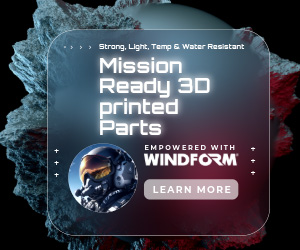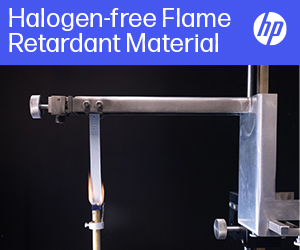Air Force Institute of Technology Welcomes Metal 3D Printing with Acquisition of Concept Laser M2 Cusing Machine
 The Air Force Institute of Technology (AFIT) at Wright-Patterson Air Force Base is no newcomer to 3D printing; the school has been using the technology to build polymer prototypes for more than three decades. This month, however, AFIT decided to take a big step forward into metal additive manufacturing. The institute’s Graduate School of Engineering and Management recently acquired a Concept Laser M2 metal 3D printer – a huge investment that shows that AFIT isn’t messing around; the school is serious about implementing metal 3D printing.
The Air Force Institute of Technology (AFIT) at Wright-Patterson Air Force Base is no newcomer to 3D printing; the school has been using the technology to build polymer prototypes for more than three decades. This month, however, AFIT decided to take a big step forward into metal additive manufacturing. The institute’s Graduate School of Engineering and Management recently acquired a Concept Laser M2 metal 3D printer – a huge investment that shows that AFIT isn’t messing around; the school is serious about implementing metal 3D printing.
AFIT’s acquisition of the M2 comes shortly after the US Naval Research Laboratory purchased one – another sign of the military’s increasing use of additive manufacturing technology across branches. The M2 isn’t an inexpensive machine; it’s close to a million dollars, so investing in one is no snap decision. According to Major Ryan O’Hara, assistant professor at the Graduate School of Engineering and Management and AFIT’s additive manufacturing lead, they chose the M2 because, compared to other printers, it requires minimal handling of the metal powder.
“This is a fairly automated process that is conducted in an isolated and modular system,” he said. “Other systems may have a lot more user handling of the powder. We chose this one to limit exposure.”
AFIT plans to use the M2 to advance the production and use of three major aerospace metals: titanium, aluminum and inconel. It will position the school as an expert resource for the Air Force to consult on the implementation of additively manufactured metal components for flight-critical and aerospace applications.
“Ultimately, this is a capability that enhances the defense focused graduate research that we are already doing, whether that is to produce prototypes faster or get someone into the lab for practical experimentation – those are all things we’ve traditionally done in polymers to facilitate research and technology applications, and now we’re applying these techniques with metal,” said Major O’Hara. “In a recent project, we were able to decrease weight by 10 to 20 percent while increasing stiffness by 20 to 30 percent. The big advantage there is we can design lighter and stiffer structures that can respond to aerospace environments while delivering greater capabilities.”
Wright-Patterson Air Force Base is also home to the Air Force Research Laboratory (AFRL), which has been conducting in-depth research and work with additive manufacturing for aerospace and other applications. AFIT’s investment in metal additive manufacturing only strengthens the site as a hub for advanced manufacturing research and development. Until now, AFIT had to outsource any of the metal parts it needed for its multiple areas of additive manufacturing-related research.
“This is a significant investment for us,” said Dr. Todd Stewart, AFIT director and chancellor. “We’re staying on top of emerging and obviously important technology. I’m excited about that. I understand that this offers somewhat unique capabilities for our Air Force and for our students and faculty.”
“This particular machine, in this region, represents the leading edge of additive manufacturing,” added Dr. Adedeji Badiru, dean, Graduate School of Engineering and Management. “There are many pockets of additive manufacturing around the Dayton area. We are hoping this new capability will lead to collaboration with the Air Force so we can gain more direct applications.”
![]() The M2 offers a large build area of 250 x 250 x 280 mm, with a layer resolution of 20 to 80 micrometers, making it well-suited to the Air Force’s research areas, many of which involve lattice structures. Dr. Eric Swenson, associate professor, Department of Aeronautics and Astronautics, is excited about the overall design freedom that the machine will allow students and professors.
The M2 offers a large build area of 250 x 250 x 280 mm, with a layer resolution of 20 to 80 micrometers, making it well-suited to the Air Force’s research areas, many of which involve lattice structures. Dr. Eric Swenson, associate professor, Department of Aeronautics and Astronautics, is excited about the overall design freedom that the machine will allow students and professors.
“It’s a pretty fantastic way to go,” he said. “In the long run, it is a lot less expensive. If you find a little problem area, you can fix it and print it again. You can then iterate to a really interesting, fast solution and build spacecraft parts quickly and easily, totally moving the research forward.”
“There is so much we can do. It’s going to be exciting when we start getting results and being able to publish papers on novel science that no one else has ever done,” said Benjamin Doane, a research assistant at the Center for Space Research and Assurance at AFIT. “The possibilities are endless. We can now start printing parts that we can test and compile their data, it is going to be pretty cool.”
Discuss in the AFIT forum at 3DPB.com.
Subscribe to Our Email Newsletter
Stay up-to-date on all the latest news from the 3D printing industry and receive information and offers from third party vendors.
You May Also Like
3D Printing Webinar and Event Roundup: December 8, 2024
This week, we’ve got a number of webinars, on topics from 3D printing software and medical applications to printed electronics, PVC for industrial 3D printing, and more. There are also...
Innovations in Electronics and Additive Manufacturing: Highlights from Electronica and Formnext 2024
In November, J.A.M.E.S. participated in two big industry events: Electronica and Formnext 2024. These international events have been a good opportunity for J.A.M.E.S to show our ability in 3D-printed electronics...
Printing Money Episode 24: Q3 2024 Earnings Review with Troy Jensen, Cantor Fitzgerald
Welcome to Printing Money Episode 24. Troy Jensen, Managing Director of Cantor Fitzgerald, joins Danny Piper, Managing Partner at NewCap Partners, once again as it is time to review the...
Department of Defense Spent Almost $1B Directly on 3D Printing in 2024, AMR Reports
Additive Manufacturing Research (AM Research) has released its latest market study, “Additive Manufacturing in Military and Defense 2024“, revealing substantial growth in the sector’s adoption of 3D printing technologies. This...




































